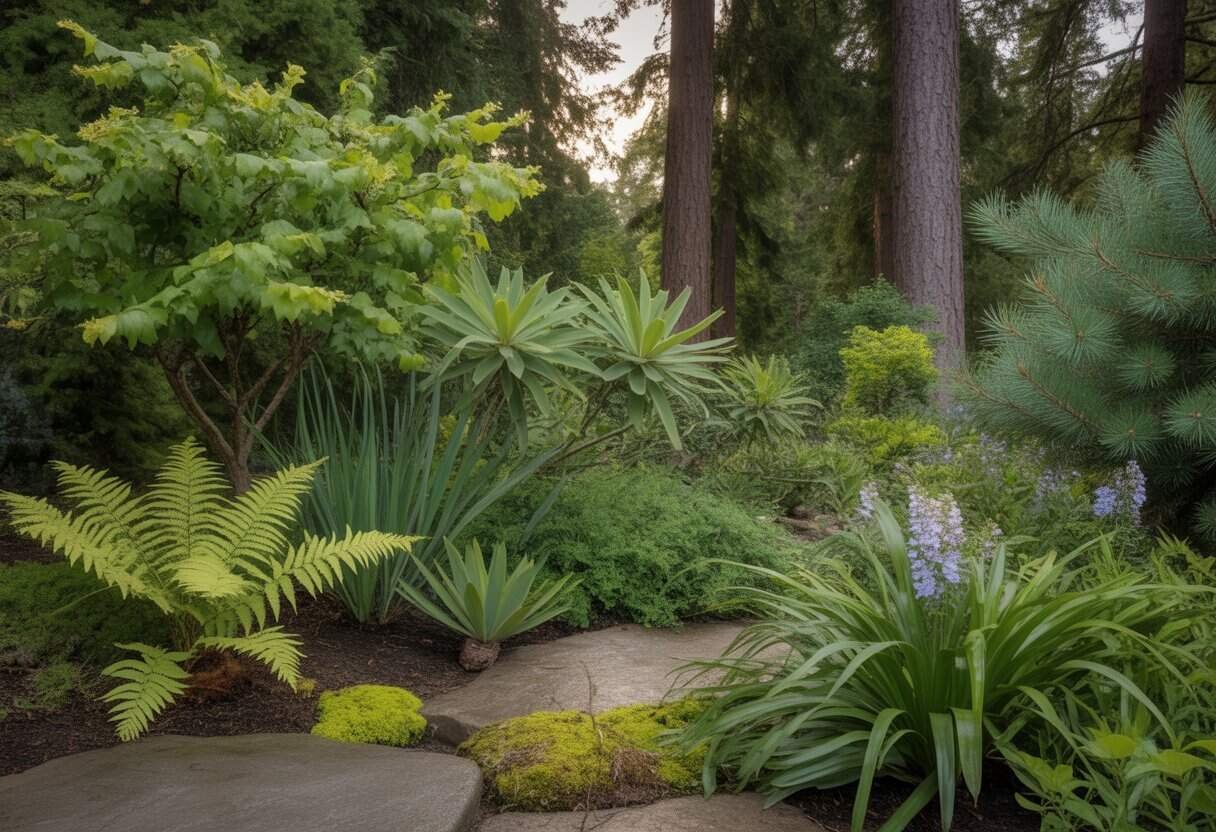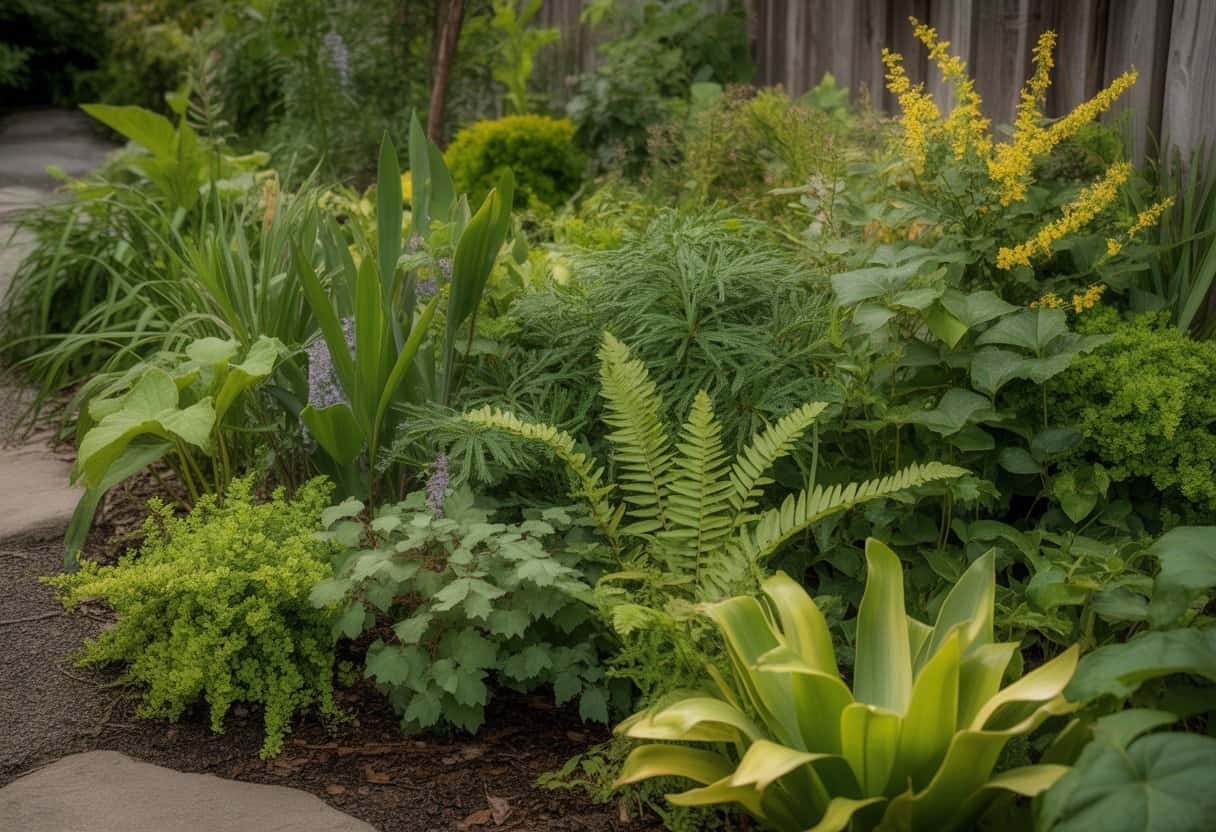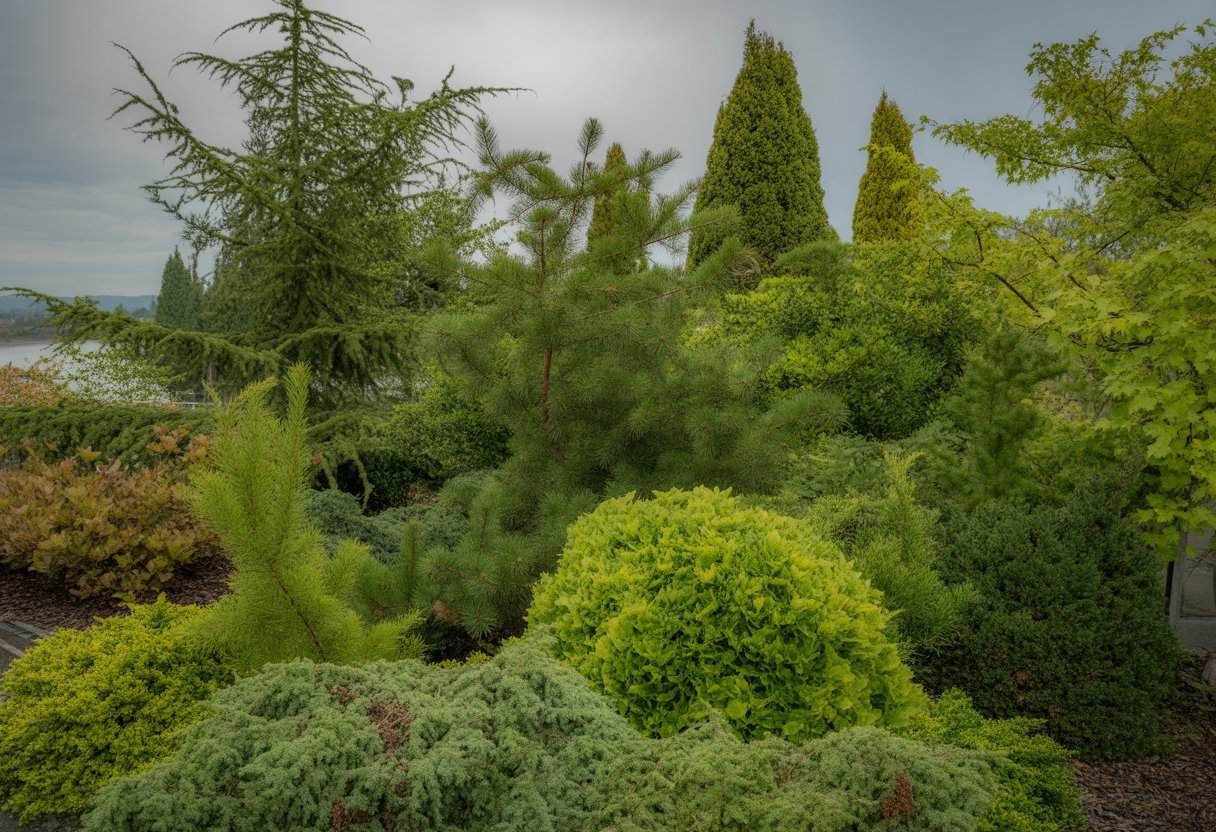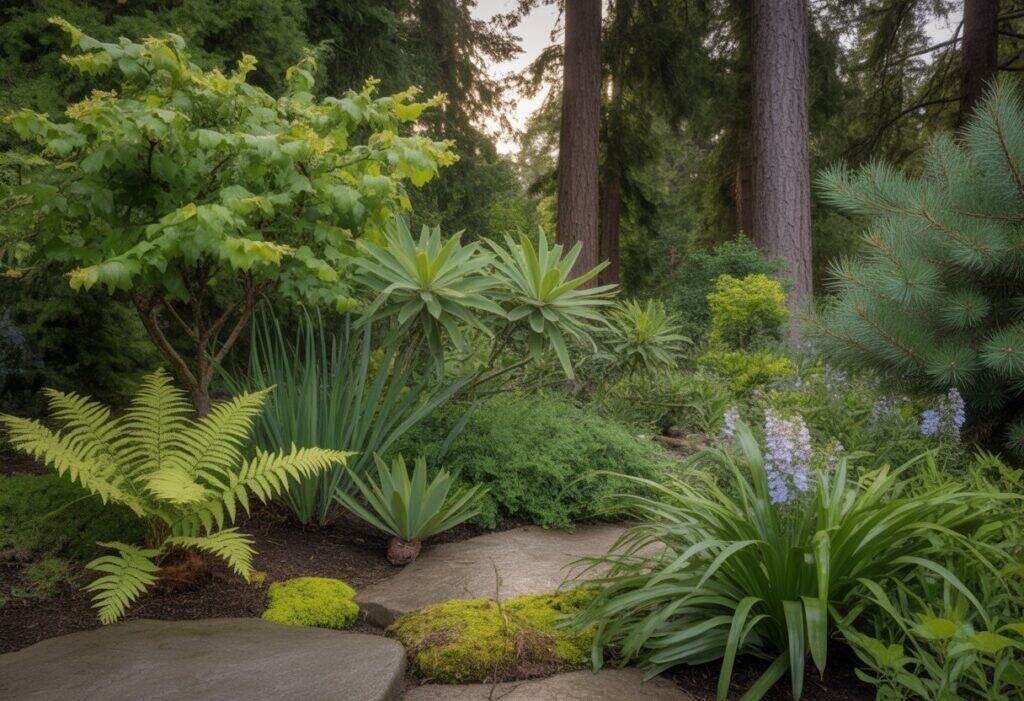Oregon’s native plants offer beautiful, sustainable landscaping options. These plants evolved in Oregon’s unique climate and soil, so they thrive with minimal maintenance.
From wildflowers to majestic trees, native plants provide endless design possibilities. They bring color, texture, and structure to any garden.

Using native Oregon plants in your landscape can reduce water usage and eliminate the need for fertilizers. They also create important habitat for local wildlife, including birds, butterflies, and beneficial insects.
These plants resist local pests and diseases naturally. You can spend less time on garden problems and more time enjoying your outdoor space.
Native plant landscaping connects your garden to Oregon’s natural heritage. Oregon’s diverse native flora provides options for every setting and style.
Key Takeaways
- Native Oregon plants need less water, fertilizer, and maintenance.
- These plants support local wildlife, including pollinators and birds.
- Incorporating natives creates resilient landscapes that reflect Oregon’s natural beauty.
The Benefits of Native Oregon Plants for Landscaping
Native Oregon plants offer many advantages for home landscapers. They have evolved for Oregon’s climate and soils, so they are ideal for sustainable gardens.
Environmental Advantages
Native plants help restore Oregon’s natural ecosystems in your backyard. Their deep root systems prevent soil erosion, which is especially important in Oregon’s rainy western regions.
Unlike exotic species, native plants do not need chemical fertilizers or pesticides. This reduces harmful runoff into local waterways and protects the Willamette Valley’s watershed.
Native species like Oregon grape and red-flowering currant improve soil health over time. They adapt to local soil chemistry and contribute to nutrient cycling.
Using natives reduces the carbon footprint of landscaping. These plants need fewer resources for maintenance and support ecological processes that help combat climate change.
Wildlife Support and Biodiversity
Native plants provide essential habitat for local wildlife. Birds, butterflies, and beneficial insects rely on these plants for food and shelter.
Specific plant-animal relationships exist that non-native plants cannot replace. For example, the Oregon white oak supports over 200 wildlife species, including many native butterflies.
Creating wildlife corridors with natives helps animals move safely between natural areas. Even small gardens with Pacific Northwest natives can act as stepping stones for wildlife.
Plants like snowberry and salal produce berries that feed birds during winter. Native flowering plants such as camas and lupine provide nectar for native pollinators when they need it most.
A diversity of native plants restores natural food webs. Balanced ecosystems develop as pest species are controlled by natural predators.
Maintenance and Water Conservation
Once established, native plants require minimal care. Their adaptation to Oregon’s climate means they thrive with little intervention.
Water conservation is a major benefit of native landscaping. Plants like kinnikinnick and Oregon sunshine withstand summer drought and rarely need extra watering.
Annual Maintenance Comparison:
| Task | Native Garden | Non-Native Garden |
|---|---|---|
| Watering | 70% less | Regular |
| Fertilizing | None | 2-4 times yearly |
| Pest control | Rarely needed | Often required |
Native plants develop deep, efficient root systems. These roots access groundwater better than many non-natives, reducing irrigation needs.
Most Oregon natives do not require pruning or deadheading. This creates a relaxed gardening experience with less yard waste.
Aesthetic and Seasonal Appeal
Native landscapes offer year-round visual interest with seasonal changes. Spring wildflowers and fall color provide evolving scenery.
The textures and forms of native plants create dynamic landscapes. Mix evergreen shrubs like salal with deciduous plants like vine maple for contrast throughout the year.
Many natives offer spectacular blooms. Pacific rhododendron, mock orange, and red columbine add vibrant colors during their bloom periods.
Fall brings dramatic color changes to plants like vine maple and Oregon grape. Their foliage turns red, orange, and gold.
Winter interest comes from colorful berries and interesting bark. Red osier dogwood’s bright stems and snowberry’s white fruits stand out against winter’s backdrop.
Design Principles for Native Oregon Plant Gardens

Creating beautiful landscapes with Oregon’s native plants starts with careful planning. The right approach balances ecological function with visual appeal.
Site Assessment and Planning
Begin by examining your property’s conditions. Note sunny and shady areas, soil types, and drainage patterns.
A landscape designer can help identify microclimates that support different native plant communities. Observe your land through different seasons to see patterns that affect plant success.
Record where water collects or the ground dries quickly. Consider your goals for the space, such as attracting wildlife, creating privacy, or establishing low-maintenance areas.
The Native Plant Society of Oregon offers resources to match plants with specific site conditions and purposes. Map your property and create zones based on water needs.
Group plants with similar requirements together. This maximizes efficiency and plant health.
Combining Plant Types Effectively
Layer your garden to mimic natural ecosystems. Include groundcovers, perennials, shrubs, and trees for visual interest and ecological benefits.
Pay attention to plant height and growth habits. Place taller plants in the back and shorter ones in front for visibility.
Allow enough space for plants to reach their mature size. Mix plants with different bloom times for year-round interest.
Early spring bloomers like Red-flowering Currant pair well with summer-flowering Goldenrod and fall-blooming Asters. Create plant communities rather than isolated specimens.
For example, Oregon White Oak works well with understory shrubs like Snowberry and ground-level Western Fescue. Repeat key plants throughout your landscape to create visual cohesion.
Creating Hedgerows and Wildlife Corridors
Hedgerows provide privacy, reduce wind, and create wildlife habitat. Dense plantings of native shrubs like Oceanspray, Nootka Rose, and Oregon Grape form natural boundaries.
Design hedgerows with varied heights and densities. This attracts more wildlife and adds visual interest.
Include evergreen and deciduous plants for year-round structure. Connect habitat areas with planted corridors to help wildlife move safely through your landscape.
Even narrow strips of native plantings can serve as important links for birds and pollinators. Include plants that provide food sources throughout the year.
Berries, seeds, and nectar-rich flowers support wildlife in different seasons. Red-osier Dogwood and Pacific Ninebark offer both beauty and valuable habitat.
Choosing Trees and Large Shrubs for Oregon Landscapes

Native trees and large shrubs form the backbone of Oregon landscapes. They provide structure, shade, and habitat while needing less maintenance than non-native species once established.
Evergreen Trees
Douglas fir (Pseudotsuga menziesii) is Oregon’s most iconic evergreen tree. It reaches 80-200 feet in the wild but adapts to residential settings when given space.
This tree features soft, blue-green needles and distinctive cones. Western red cedar (Thuja plicata) offers fragrant, scale-like foliage and reddish-brown bark.
It thrives in moist conditions and can live for centuries. Shore pine (Pinus contorta) grows 20-40 feet tall with twisted branches and paired needles.
This tree tolerates poor soils and coastal conditions. Western hemlock (Tsuga heterophylla) prefers shadier spots with consistent moisture.
Its drooping branch tips and small cones create an elegant silhouette in larger yards. Western yew (Taxus brevifolia) grows slowly to 15-45 feet and has distinctive red berries on female plants.
Large Deciduous Trees
Big leaf maple (Acer macrophyllum) creates spectacular fall displays with giant yellow leaves. These fast-growing natives reach 40-75 feet and provide excellent shade.
Red alder (Alnus rubra) grows quickly to 40-80 feet with smooth, light gray bark and oval leaves. This species improves soil quality by fixing nitrogen.
Vine maple (Acer circinatum) functions as a small tree or large shrub, reaching 15-25 feet. Its palmate leaves turn orange-red in autumn.
Oregon white oak (Quercus garryana) develops a broad crown when grown in open areas. These slow-growing trees live for centuries and support many wildlife species.
Oregon ash (Fraxinus latifolia) thrives in moist areas. It develops a rounded crown and compound leaves that turn yellow in fall.
Native Large Shrubs
Pacific rhododendron (Rhododendron macrophyllum) produces pink blooms in spring. This evergreen shrub reaches 8-12 feet and prefers woodland settings with acidic soil.
Red-flowering currant (Ribes sanguineum) bursts with pink-to-red blossoms in early spring. Growing 6-10 feet tall, it attracts hummingbirds and tolerates drought.
Osoberry (Oemleria cerasiformis) blooms very early with clusters of white flowers followed by small purple fruits. This 6-15 foot shrub works well in woodland gardens.
Salal (Gaultheria shallon) forms a dense evergreen hedge 3-6 feet tall with leathery leaves and white-to-pink flowers. It spreads slowly through underground stems.
Serviceberry (Amelanchier alnifolia) offers white spring flowers, edible berries, and orange-red fall color on a 10-15 foot frame.
Selecting the Right Tree for Your Yard
Match your tree choice to your specific site conditions. Consider soil moisture, sun exposure, and available space for both height and spread at maturity.
Native trees need regular watering during their first 2-3 years. After that, most need minimal irrigation except during severe drought.
Avoid planting large trees near utilities, foundations, or hardscapes. A tree’s root system often extends 2-3 times wider than its canopy.
Look for trees that provide flowers, fall color, interesting bark, or wildlife value. This ensures year-round landscape appeal.
Consider growth rate when planning. Fast-growing species like alder provide quick results, while slower-growing trees like oak have longer lifespans.
Native Shrubs and Small Trees for Structure and Color
Oregon’s native shrubs and small trees offer natural beauty and wildlife habitat. These plants thrive in local conditions and provide year-round interest.
Small Deciduous Trees
Native deciduous trees add seasonal changes and vertical interest. Cascara (Rhamnus purshiana) grows 15-30 feet tall with glossy leaves and berries that attract birds.
It tolerates shade and moist conditions. Pacific Crab Apple (Malus fusca) provides spring blossoms and fall fruit, growing 15-25 feet tall.
Wildlife love its small apples. Serviceberry (Amelanchier alnifolia) offers white spring flowers, edible purple berries, and brilliant fall color.
It typically reaches 10-15 feet in height. Creek Dogwood (Cornus sericea) features bright red stems in winter and white flower clusters in spring.
It prefers moist areas and grows 6-12 feet tall. Oregon White Oak (Quercus garryana) is a slow-growing tree that provides essential wildlife habitat.
Young specimens work well in larger landscapes.
Small Evergreen Shrubs
Evergreen shrubs keep their structure and add interest throughout winter. Tall Oregon Grape (Mahonia aquifolium) has yellow flowers in early spring and blue-black berries.
This shrub grows 3-10 feet tall. Evergreen Huckleberry (Vaccinium ovatum) produces small, edible berries and has glossy leaves.
It thrives in partial shade and reaches 3-8 feet in height. Kinnikinnick (Arctostaphylos uva-ursi) forms a dense groundcover with small pink flowers and red berries.
It rarely grows taller than 1 foot but spreads widely. Wax Myrtle (Morella californica) has aromatic foliage and grows 6-12 feet tall.
It tolerates coastal conditions and poor soils.
Popular Native Shrub Varieties
Red Flowering Currant (Ribes sanguineum) displays bright pink-red blossoms in early spring. It grows 6-10 feet tall and attracts hummingbirds.
Oceanspray (Holodiscus discolor) has cascades of creamy white flowers in summer. It reaches 6-10 feet and adapts to many conditions.
Salmonberry (Rubus spectabilis) produces pink flowers and edible orange berries. It prefers moist soil and grows 4-10 feet tall.
Pacific Ninebark (Physocarpus capitatus) has peeling bark, white flower clusters, and reddish seed pods. It grows well in both sun and shade.
Twinberry (Lonicera involucrata) features yellow flowers with red bracts and black berries. It grows 5-10 feet tall and likes moist soil.
Red Elderberry (Sambucus racemosa) produces white flowers and bright red berries. Birds flock to this 5-12 foot shrub that tolerates part shade.
Perennials and Wildflowers for Seasonal Interest
Native Oregon perennials and wildflowers add color throughout the year and support local ecosystems. These plants thrive in Oregon’s diverse climate with little maintenance once they are established.
Oregon Native Perennials
Oregon’s native perennials return each year for reliable beauty. Yarrow (Achillea millefolium) grows 1-3 feet tall with flat-topped white flower clusters from spring through fall.
This drought-tolerant plant suits sunny borders or meadow gardens. Fringecup (Tellima grandiflora) thrives in woodlands with dappled shade.
Its small, fringed flowers rise on 2-foot stems above evergreen foliage. This perennial handles dry summers once established.
Oregon Sunshine (Eriophyllum lanatum) offers bright yellow daisy-like flowers from late spring through summer. It grows 1-2 feet tall and performs well in full sun and poor soils.
Spirea douglasii (Western Spirea) produces pink flower plumes in summer that attract pollinators. This shrub reaches 3-6 feet tall and tolerates both wet winter soils and summer drought.
Wildflowers for Pollinators
Wildflowers support pollinators in native gardens. California Poppy (Eschscholzia californica) produces bright orange blooms from spring through fall.
These drought-tolerant flowers self-seed and attract bees and beneficial insects. Coast Penstemon (Penstemon serrulatus) shows off purple-blue tubular flowers that hummingbirds love.
It grows 1-2 feet tall and blooms from late spring through summer in sunny spots. Native Columbine (Aquilegia formosa) offers red and yellow flowers on delicate stems.
This plant grows in part shade to sun and provides nectar for hummingbirds. Lupine species, including Riverbank Lupine (Lupinus rivularis), produce spikes of blue, purple, or pink flowers.
These nitrogen-fixing plants improve soil and support many butterfly species.
Blooming and Color Cycles
Planting native perennials with different bloom times keeps the garden interesting year-round. Early bloomers like Maybud (Maianthemum racemosum) show white flower plumes in spring, followed by red berries in fall.
Mid-season bloomers include most lupines, penstemons, and yarrow. These plants offer nectar during the busy summer months for pollinators.
Fall color comes from late-blooming perennials and seedheads. Oregon Sunshine continues blooming into autumn, and yarrow’s dried seedheads add texture and food for birds in winter.
Consider these bloom times when planting:
- Early Spring: Columbine, Fringecup
- Late Spring: Lupine, Maybud
- Summer: Yarrow, Penstemon, Spirea
- Late Summer/Fall: Oregon Sunshine, California Poppy
Mixing bloom periods ensures constant color and pollinator support.
Ground Covers, Grasses, and Succulents for Low-Maintenance Spaces
Oregon’s native plants provide low-maintenance options for ground covers, grasses, and succulents. These plants thrive in the local climate with minimal care.
Native Ground Covers
Native ground covers form dense mats that suppress weeds and cut down on maintenance. Fragaria chiloensis (Coastal Strawberry) spreads by runners, creating a carpet of glossy green leaves and white flowers.
These flowers become small, edible berries. Bunchberry (Cornus canadensis) grows 4-8 inches tall and has white flowers and bright red berries.
It thrives in shady woodland settings. Oxalis oregana (Oregon Wood Sorrel) covers the forest floor with clover-like leaves that fold down at night.
Its delicate white or pink flowers bloom in spring. Miner’s Lettuce fills shady spots with edible, vitamin-rich leaves.
This plant self-seeds and fills bare areas with little effort.
Low-Growing Grasses and Sedges
Carex obnupta (Slough Sedge) grows well in wet areas or rain gardens. This sedge grows 2-3 feet tall with graceful, arching leaves and tolerates both water and drought.
Deschampsia cespitosa (Tufted Hair Grass) forms clumps 2-3 feet tall with airy seed heads. These seed heads catch the light and provide winter interest.
Common Rush (Juncus effusus) adds strong vertical lines to the landscape. This plant thrives in moist areas but tolerates dry conditions once established.
Native Grass Benefits:
- Drought tolerance after establishment
- Wildlife habitat and food
- Erosion control on slopes
- Year-round visual appeal
Oregon Natives for Sunny and Shady Spots
For sunny areas, Veronica liwanensis (Turkish Speedwell) creates a dense mat of green leaves with bright blue flowers in spring. It tolerates some foot traffic and drought after it settles in.
Kinnikinnick (Arctostaphylos uva-ursi) thrives in sun to partial shade with evergreen leaves and red berries that attract birds. This ground cover handles poor soils and slopes well.
For shade, Inside-Out Flower (Vancouveria hexandra) offers fern-like foliage and unique white flowers. It spreads slowly to form colonies in woodland gardens.
Fringe Cups (Tellima grandiflora) works in many light conditions. It has maple-like leaves and tall stalks of fringed flowers for shady spots.
Succulents and Unique Foliage
Sedum spathulifolium (Broadleaf Stonecrop) stands out with blue-green leaves that can turn red in sun or cold. Its yellow star-shaped flowers attract pollinators.
Lewisias are native succulents that thrive in rock gardens and crevices. Their colorful blooms rise above fleshy leaf rosettes and suit dry spots.
Oregon Stonecrop (Sedum oreganum) forms an evergreen mat that turns bronze-red in winter. This drought-tolerant succulent needs little care.
Best Uses for Native Succulents:
- Rock gardens
- Green roofs
- Between stepping stones
- Dry slopes
Expert Tips and Resources for Native Plant Landscaping in Oregon
Success with native Oregon plants starts with good sourcing, reliable information, and proper care. Local experts offer advice for creating thriving native landscapes.
Where to Source Native Plants
Getting quality native plants is important for landscaping success. Oregon has several nurseries that specialize in native species.
Blooming Junction Farm and Garden in Cornelius offers a wide range of native plants for Oregon gardens. Their staff can help you choose plants for your soil and light conditions.
Grace Dinsdale’s Plantworks Nursery in Healdsburg is known for high-quality native plants and expert advice. For coastal gardens, Lincoln County Native Plants supplies species suited to salt spray and sandy soils.
Many nurseries hold native plant sales in spring and fall when planting is easiest. Call ahead, as popular natives can sell out.
Recommended Organizations and Publications
Several organizations offer helpful resources for native plant gardening in Oregon.
Native Plant Society of Oregon (NPSO) provides:
- Monthly meetings with experts
- Field trips to natural areas
- Plant guides for different Oregon regions
- The “Kalmiopsis” journal with detailed articles
Oregon State University Extension Service publishes free guides on native plant selection and care. Their website has downloadable instructions and maintenance calendars.
The Oregon Flora Project maintains a database of native species with growing details. Their “Flora of Oregon” book is a key reference for plant identification.
Conservation groups often host workshops and share online resources about local native plants for home gardens.
Maintenance Best Practices
Native plants need less care than exotic species, but good maintenance helps them thrive. Learn about their natural growth habits.
Water deeply but not often during the first two years. Most Oregon natives grow best with wet winters and dry summers.
After they are established, many species need little extra watering except during severe drought. Avoid fertilizing established native plantings.
Oregon natives adapt to local soils and may suffer from too much fertilizer. Too many nutrients can cause weak growth and more disease.
Mulch with leaf litter or wood chips to control weeds and keep soil moist. Use a 2-3 inch layer, but keep mulch away from stems to prevent rot.
Prune only when needed for health or appearance. Most natives look best with little pruning. Remove only dead or damaged branches.
Frequently Asked Questions
Native Oregon plants work well in landscapes and thrive with little care. These plants support local wildlife and create beautiful, sustainable gardens for Oregon’s climate.
What are the top low maintenance native Oregon plants for landscaping?
Oregon Grape (Mahonia aquifolium) needs little care after it is established. This evergreen shrub has yellow flowers in spring and purple berries in summer.
Kinnikinnick (Arctostaphylos uva-ursi) forms a dense groundcover that rarely needs pruning. It thrives in poor soils and requires little water.
Sword Fern (Polystichum munitum) grows well in shade with little care. These hardy ferns stay green year-round in most Oregon climates.
Red-flowering Currant (Ribes sanguineum) only needs occasional pruning. It attracts hummingbirds with its pink-red flowers in early spring.
Which native Oregon plants thrive best in full sun conditions?
Yarrow (Achillea millefolium) thrives in sunny, dry spots. Its feathery leaves and flat flower clusters add texture to gardens.
Oregon Sunshine (Eriophyllum lanatum) grows well in hot, sunny areas. This perennial has bright yellow daisy-like flowers.
Blue-eyed Grass (Sisyrinchium idahoense) prefers full sun and well-drained soil. Despite its name, it is related to irises.
Showy Milkweed (Asclepias speciosa) grows well in sunny spots. It provides habitat for monarch butterflies and produces interesting seed pods.
How can I identify native Oregon plants suitable for my garden?
Check your soil, sun exposure, and moisture levels. Native plant nurseries often group plants by these needs.
Watch what grows naturally near your home. Plants that thrive in your area will likely do well in your garden.
The Oregon Flora Project website has a plant finder tool. You can search by county, growing conditions, and plant features.
Local extension offices offer soil testing and plant recommendations. Their experts can help you match plants to your garden.
What are some popular evergreen plants native to Oregon for landscaping?
Western Red Cedar (Thuja plicata) provides year-round screening and wildlife habitat. You can keep this tree smaller with pruning.
Salal (Gaultheria shallon) has glossy green leaves all year. It grows well in shade and produces berries that wildlife enjoy.
Pacific Wax Myrtle (Morella californica) keeps dense evergreen foliage. This shrub tolerates coastal conditions and poor soils.
Tall Oregon Grape (Mahonia aquifolium) has holly-like leaves that stay green all year. Its yellow flowers and blue berries add interest in multiple seasons.
Where can I buy native plants for landscaping in Oregon?
Native plant nurseries specialize in locally adapted species. Portland Nursery, Bosky Dell Natives, and Echo Valley Natives offer many options.
Watershed councils and conservation groups hold annual native plant sales. These events usually happen in spring and fall.
The Native Plant Society of Oregon hosts plant sales. Their website lists sellers by region.
Many conventional nurseries now offer native plant sections. Ask staff about plants grown from local genetic stock for the best results.
Can you list native Oregon flowering plants ideal for home landscapes?
Camas (Camassia quamash) produces striking blue-purple flower spikes in spring. This bulb naturalizes easily in meadow gardens and tolerates seasonal wetness.
Western Columbine (Aquilegia formosa) attracts hummingbirds with its distinctive red and yellow flowers. It self-seeds gently and forms naturalized colonies.
Oregon Iris (Iris tenax) displays vibrant purple blooms in late spring. These drought-tolerant perennials thrive in rock gardens and sunny borders.
Meadow Checkermallow (Sidalcea campestris) produces pink flowers on tall stems. It adds vertical interest to garden beds and supports native pollinators.


